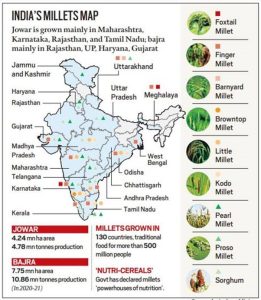29 Nov Millets Production in India
Millets Production in India
This article is based on the “Millets Production in India”. It talks about the Environmental Ecology and India’s Economy significance of Millets Production.
Relevance for Prelims: Millets Production statistics, Climate Resilient Crops
Relevance for Mains: Significance of Millets
Context: United Nation hon India’s advice has declared 2023 as the “International year of Millets”
About Millets:
- Millet is a collective term referring to the number of small-seeded annual grasses that are cultivated as grain crops, primarily on marginal lands in dry, temperate areas and tropical regions.
- They are also called Nutri-cereals, such as jowar, bajra and ragi and minor millets such as kodo, kutki, kakun, sanwa, cheena and kuttu.
- India is the largest producer of millet in the world.
Significance of Millets
- Superfoods: They are nutritionally superior to paddy and wheat which is a staples for every other person in India. They also have high protein, fiber, and mineral-like content.
- Tackle malnourishment: They could provide nutritional security and act as a shield against nutritional deficiency, especially among vulnerable groups such as children and women.
- Low Glycemic Index: Being low glycemic in nature, they can help in tackling lifestyle problems and health challenges such as obesity and diabetes as they are gluten-free.
- Super Crop: They are photo-insensitive (meaning -they do not require a specific photo period for flowering) and resilient to climate change. They can grow in poor soils.
- Carbon Efficient: They have low and water footprint as compared to rice, wheat and sugarcane which are considered as water-guzzlers.

Pic: Millets Production in India
Government initiatives to promote millet production:
- Minimum Support Price: Hike in MSP is considered an incentive for farmers and gives encouragement to produce at a large scale.
- Initiative for Nutritional Security through Intensive Millet Program: In 2011-12, the government announced the allocation of 300 crores under Rashtriya Vikas Yojana for the promotion of millets as Nutri-cereals.
UPSC PYQ Prelims:
With reference to ‘Initiative for Nutritional Security through Intensive Millets Promotion’, which of the following statements is/are correct? (2016)
- This initiative aims to demonstrate the improved production and post-harvest technologies and to demonstrate value-addition techniques, in an integrated manner, with a cluster approach.
- Poor, small, marginal, and tribal farmers have a larger stake in this scheme.
- An important objective of the scheme is to encourage farmers of commercial crops to shift to millet cultivation by offering them free kits of critical inputs of nutrients and micro irrigation Equipment.
Select the correct answer using the code given below:
(a) 1 only
(b) 2 and 3 only
(c) 1 and 2 only
(d) 1, 2 and 3
Source:
Daily Current Affairs for UPSC
Current affairs are very important for any IAS aspirant. Every UPSC aspirant should read daily current affairs every day for preparing UPSC exam. Without Reading about current affairs, No one can pass the mains, prelims, and interview examinations under UPSC. So read daily current affairs for your UPSC exam preparation from Plutus IAS.



No Comments